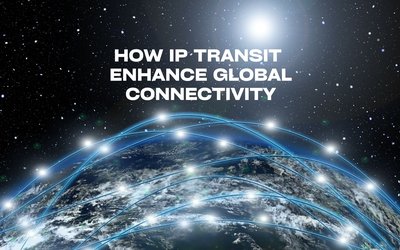Our blog
>
IP Transit vs. IP Peering: What SMBs Need to Know
In the rapidly evolving digital landscape, businesses, especially Small and Medium-sized Businesses (SMBs), are constantly seeking efficient and cost-effective solutions to improve their online presence and connectivity. A significant aspect of this endeavor involves understanding the intricacies of internet connectivity options, specifically IP transit and IP peering. Both play pivotal roles in how data is transferred across the internet but serve different purposes and benefits. This article aims to demystify these concepts, helping SMBs like yours make informed decisions tailored to your connectivity needs.
What is IP Transit?
IP Transit is a service that allows your network to access the entire internet. In simpler terms, it's akin to a comprehensive package that grants your network the ability to communicate with all other networks on the internet, not just a select few. This is achieved by purchasing access from an Internet Service Provider (ISP) or a larger network provider, which has established connections with other networks globally.
The primary advantage of IP Transit is its universality. By opting for IP Transit, SMBs can ensure their services are accessible from anywhere in the world, making it an ideal choice for businesses looking to reach a global audience. Additionally, providers often guarantee a certain level of service quality, including bandwidth, uptime, and support, which is crucial for businesses relying heavily on internet connectivity.
What is IP Peering?
On the flip side, IP Peering is a mutual agreement between two or more network providers to exchange traffic between their networks freely. It's a more selective approach compared to IP Transit, as it only involves direct or indirect connections to the networks your provider has agreements with. The primary motive behind peering is to reduce the costs associated with traffic exchange and improve the performance and efficiency of data transfer.
IP Peering is particularly beneficial for content-heavy operations that demand high-speed data transfer rates and reduced latency. By enabling a more direct route for data exchange, IP Peering can significantly enhance the user experience for services such as streaming, gaming, and large-scale file transfers.
Experience the Power of Nexthop`s Agile and Reliable Telecommunication Solutions
Contact Us Today and Future Proof Your Business Connectivity
Sydney
/
Melbourne
/
Brisbane
/
Perth
IP Transit vs. IP Peering: Key Differences
Scope of Access: IP Transit provides access to the entire internet, whereas IP Peering is limited to the networks involved in the peering agreement.
Cost Structure: IP Transit services are typically charged based on the volume of data transmitted, reflecting the comprehensive access and services provided. IP Peering, while often less expensive, requires both parties to have roughly equal benefits from the exchange, making it a less viable option for smaller networks.
Performance: IP Peering can offer lower latency and higher throughput between peered networks, but IP Transit guarantees universal access, which is essential for businesses targeting a global audience.
Scalability: IP Transit scales with your business, as providers can offer more bandwidth or enhanced services as your needs grow. IP Peering arrangements may need to be renegotiated or expanded, requiring more administrative effort as your network traffic increases.
Making the Right Choice for Your Business
The decision between IP Transit and IP Peering should be based on your specific business needs, including your target audience, the nature of your internet traffic, and growth aspirations. For SMBs aiming for a wide-reaching online presence without the complexities of managing multiple peering agreements, IP Transit offers a straightforward, scalable solution. Conversely, if your traffic is highly localized or concentrated within certain networks, exploring IP Peering options could yield cost and performance benefits.
How Nexthop Can Help
At Nexthop, we understand the unique challenges and opportunities that SMBs face in navigating the digital world. Our business-grade fibre solutions are designed to offer reliable, high-performance connectivity tailored to your specific needs. Whether you're exploring IP Transit solutions to broaden your global reach or considering IP Peering for more efficient regional connectivity, our team of experts is here to guide you through the options and help you make the best choice for your business.
Ready to Enhance Your Connectivity?
Contact Nexthop today to learn more about our IP Transit options and how we can support your business in achieving unparalleled connectivity. With our dedicated support and advanced network solutions, let us be your partner in driving your business forward in the digital age.
This concise overview offers a foundational understanding tailored for SMBs evaluating their IP connectivity options. By emphasizing the differences and practical implications of IP Transit and IP Peering, businesses can better navigate their choices, ensuring they opt for the solution that aligns with their strategic goals. Nexthop stands ready to provide the expertise and solutions needed to thrive in an interconnected world.





